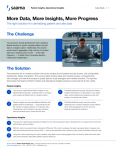Patient voice, empathy key to pediatric study design: ICON

Incorporating patient voice into a clinical trial design is important, but it can be difficult—even more so study in question centers around pediatric patients. Outsourcing-Pharma recently connected with Jacqui Whiteway, senior director in ICON’s Centre for Paediatric Clinical Development, to learn more about the finer points.
OSP: When designing study protocols, how do trial teams usually weigh in the patient—i.e., their needs and lifestyle?
JQ: Encouragingly, recently there has been a noticeable and significant effort to include patient’s needs, lifestyle, and preferences from the inception of protocol design. That said, it can be a challenge to incorporate patient input. A study protocol ultimately must effectively capture meaningful endpoints and patient outcomes that answer what is being asked - typically the effect of some intervention.
Scientists, clinicians, and experts such as statisticians are critical to ensuring these elements of protocol design are included. Protocols must also be compliant with legal and regulatory requirements. Thus, patient input that can be incorporated into a protocol is constricted by these not inconsequential factors. However, the positive impact of patient insights on protocol design can be significant with regard to patient enrolment, retention, and satisfaction.
Communication with patient partners about what is needed, and what the restrictions are, is critical. Prior to reaching out to patients, being clear on what is known, what is needed, and how to communicate is essential to prevent duplication of effort and ensure there are actionable insights.
Ideally, those designing the study should partner with patients to get input either right from the inception of the study design, or soon after a draft protocol. Either way, the patient insights should be timely such that they can actually be implemented.
There is no single way to obtain patient input, nor are the different ways mutually exclusive. Patient partners can provide input as part of a patient or community advisory board, a focus group, or as individuals. Obtaining the feedback can be done via live and virtual meetings, interviews, or surveys. Having a mix of feedback is beneficial, including from patients with both a lot of experience with clinical trials and those with less so.
Having clinical trial teams that are focused on particular patient populations, such as pediatrics, allows best practices and lessons learned to be applied to any study designs involving those populations. The schedule of events, trial endpoints, scales used, and eligibility criteria must be reviewed with the patient’s perspective in mind, and many of these perspectives are not specific to a condition.
OSP: Please talk about some of the things that get tend to get missed about the patient experience at the design stage.
JQ: Protocol templates, which are very efficient and support in ensuring compliance with legal and regulatory requirements, are very useful. In my experience, building upon these templates with the patient in mind is an important step to make sure some important elements do not get missed.
A key consideration is whether the exclusion and inclusion criteria are appropriate and truly feasible. From a scientific perspective they are often ideal, but it is important to consider if they work on a practical level for the patient. Giving these areas practical consideration often leads to their removal from protocols in favor of more workable options.
A further element that should be considered at the design stage is the frequency of visits and the number of tests and procedures. When designing a protocol the question isn’t always asked if all tests are truly needed, and if so, on that specific schedule. For example, can you streamline or combine visits or tests, such as blood draws, even if not part of the study? Participants are often patients that have medical visits and assessments outside of the trial due to their local standard of care, and this is a consideration that is often neglected.
OSP: Then, please talk about some of the additional challenges associated when the patient participants in question are children.
JW: Trials involving children are undoubtedly more complex. The most obvious challenges are associated with the fact that if there is a child participant, you are impacting a family and care circle, not just the child. Further, a child’s schedule typically involves school and extracurricular activities. By way of just one example, when considering visits, you must factor in the caregiver’s work schedule, school schedule, and other family commitments such as siblings and childcare.
Another challenge with writing a protocol for children is the range of ages. Children change a lot over the years - physiologically, psychologically, and socially - so a protocol appropriate for an 11-year-old is often not appropriate for a 5-year-old or a 15-year-old.
For example, blood tests and total blood volume limits are critical components for most trials. Depending on the age and weight of a child, the amount of blood needed for blood tests can constitute a significant volume compared to their total blood volume, and can easily exceed recommended maximum volume limits, especially when you consider there may be additional blood tests beyond the clinical trial. Thus, the number and frequency of blood tests, along with the total amount of blood taken must be considered and should be included in the protocol along with a prioritization of samples should limits be reached.
Adult trials, which typically precede the pediatric trial, do not always reflect the complexities of trials involving children, and so it is essential to consider these challenges when designing the subsequent protocol for the pediatric trial.
OSP: Please explain what an empathy map is, and how it can be useful to clinical researchers.
JW: Empathising comprises the first step in design thinking, which means gaining a deep understanding of an end user’s or customer’s perspective. An empathy map is a tool to both gain and visualize that, typically based upon interviews with end users. Empathy maps are used in a variety of contexts, from product development to assessing work environments. In clinical trials, key end users are trial participants, so an empathy map can help visualize the needs of the participants and their families.
An empathy map can take a number of forms, including one the company Sproutel uses. It is a “Hear/See/Feel/Think” map, with each of these comprising a quadrant of the map. Having this format allows the perceptions and experiences obtained from interviews of end users to be viewed so a deep understanding is obtained. The experience of generating a map ensures active listening and is a surprisingly revealing exercise. The result then is a true empathetic understanding of the end users’ experience, rather than projections or assumptions of their experience.
OSP: Could you please share a practical example of an empathy map being used to help in the design phase of a specific study? What were some of the notable findings, and how did they inform the trial team on ways design could be improved?
JW: The application of empathy maps is new in our field and was borne from ICON partnering with the “patient-centered and empathy-driven” company Sproutel. Sproutel creates products for children to aid with the mitigation of anticipatory anxiety in healthcare situations, which we see as a significant factor and contributor to medical trauma for pediatric clinical trial participants and their families. They use a Design Thinking methodology, and while this approach may be unique in the clinical trial environment, we see it as directly applicable and transferable to our industry.
Thus, we have been working together to explore how to improve the clinical trial experience for child participants and their care circles. At the recent DIA 2022 Global Annual Meeting, I chaired a workshop led by Aaron Horowitz, CEO/co-founder of Sproutel, on this very topic, which was really constructive in identifying how we can do this in real-world scenarios.
OSP: What advice would you give to a clinical research leader looking to make use of the empathy map approach in their operation?
JW: Active listening sounds easier than it is, and an empathy map is a tool that can help with this both for individuals, but also for collaboration and compilation of various insights. That is, multiple people can create empathy maps for the same purpose and thus compile these insights into strong signals for end users’ experiences and perceptions that can be translated into actionable steps.
We applied the empathy map in our workshop at the DIA 2022 Global Annual Meeting to gain an understanding of the mother of a child that has participated in clinical trials, as she is an ‘end user’ of a clinical trial, but this can be used in a number of ways, for teams, patients and site staff, among others. I would encourage leaders to use this tool for any situation where they need to listen.
OSP: Do you have anything to add?
JW: Empathy is not a nice to have, it’s a need to have that can have a practical and significant impact on clinical trial design. Listening can be hard. True active listening is not natural for most people, but borrowing from Design Thinking methodology, the empathy map is a simple tool that can be applied to do this. By using this to enhance our listening tools and develop deeper empathy, we can make a significant impact on the design and implementation of clinical trials that enhance the patient experience and drug development overall.

















